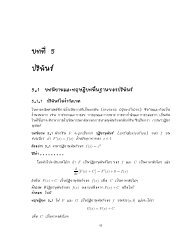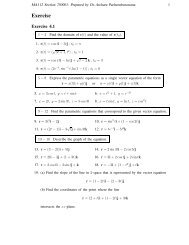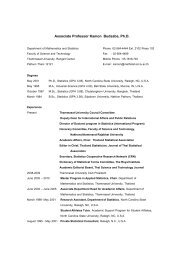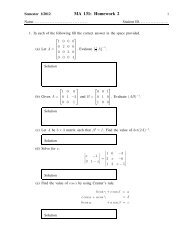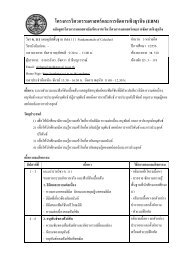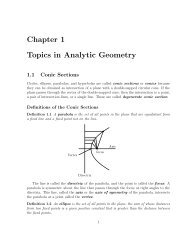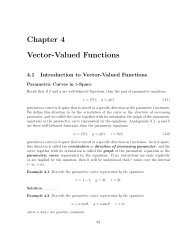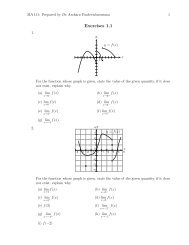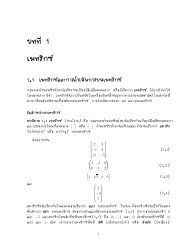Chapter 1 Topics in Analytic Geometry
Chapter 1 Topics in Analytic Geometry
Chapter 1 Topics in Analytic Geometry
You also want an ePaper? Increase the reach of your titles
YUMPU automatically turns print PDFs into web optimized ePapers that Google loves.
MA112 Section 750001: Prepared by Dr.Archara Pacheenburawana 18Solution .........Example 2.6 The curve represented by the parametric equationsx = t 2 y = t 3 (−∞ < t < +∞)is called a semicubical parabola. The parameter t can be elim<strong>in</strong>ated by cub<strong>in</strong>g x andsquar<strong>in</strong>g y, from which it follows that y 2 = x 3 .yxx = t 2 , y = t 3 (−∞ < t < +∞)The graph of this equation consists of two branches: an upper branch obta<strong>in</strong>ed by graph<strong>in</strong>gy = x 3/2 and a lower branch obta<strong>in</strong>ed by graph<strong>in</strong>g y = −x 3/2 . The two branches meet atthe orig<strong>in</strong>, which corresponds to t = 0 <strong>in</strong> the parametric equations. This is a s<strong>in</strong>gular po<strong>in</strong>tbecause the derivatives dx/dt = 2t and dy/dt = 3t 2 are both zero there. ✠Example 2.7 Without elim<strong>in</strong>at<strong>in</strong>g the parameter, f<strong>in</strong>d dy/dx and d 2 y/dx 2 at (1,1) and(1,−1) on the semicubical parabola given by the parametric equations <strong>in</strong> Example2.6Solution .........Arc Length of Parametric CurveThe follow<strong>in</strong>g result provides a formula for f<strong>in</strong>d<strong>in</strong>g the arc length of a curve from parametricequations for the curve.Arc Length Formula for Parametric CurveIf no segment of the curve represented by the parametric equationsx = x(t), y = y(t) (a ≤ t ≤ b)is traced more than once as t <strong>in</strong>crease from a to b, and if dx/dt and dy/dt are cont<strong>in</strong>uousfunctions for a ≤ t ≤ b, then the arclength L of the curve is given by√∫ b (dx ) 2 ( ) 2 dyL = + dt (2.3)dt dtaExample 2.8 F<strong>in</strong>d the circumference of a circle of radius a form the parametric equationsSolution .........x = acost, y = as<strong>in</strong>t (0 ≤ t ≤ 2π)



